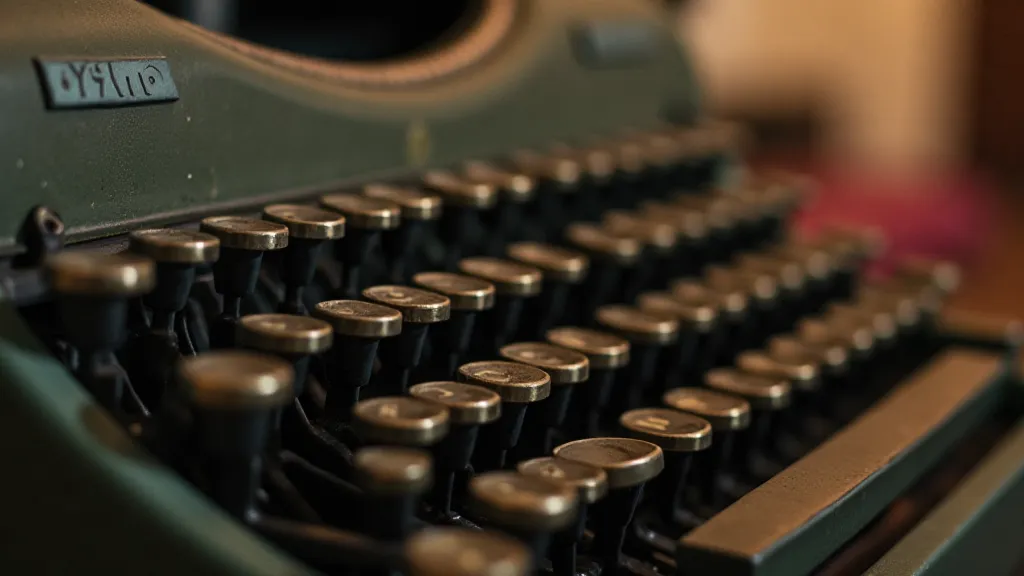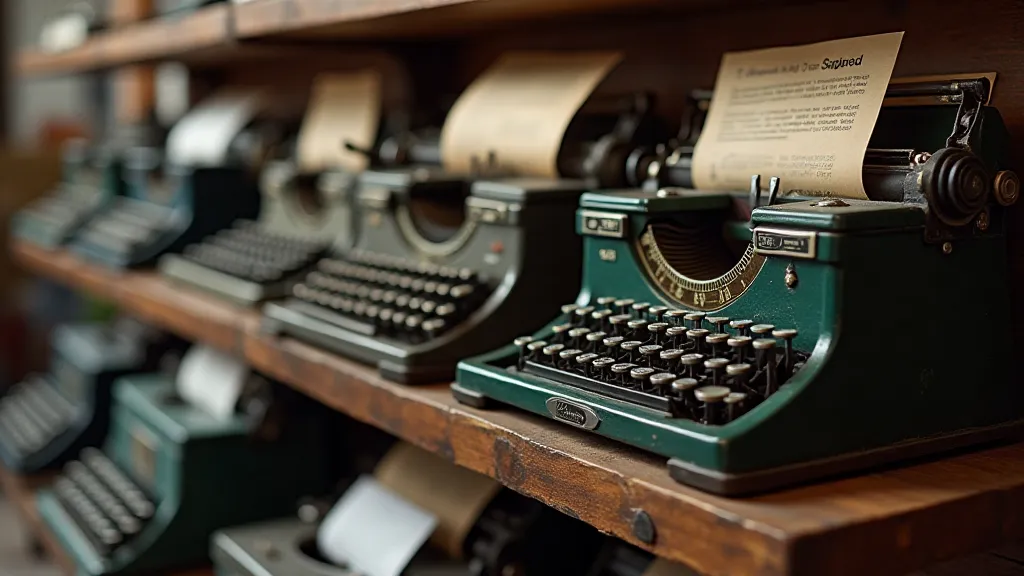The Secretary’s Cipher: Typewriters, Business, and the Rise of Women in the Workplace
The click and clack of keys. It's a sound that conjures images of bustling offices, stacks of paperwork, and the quiet efficiency of a bygone era. But within that rhythmic percussion lies a fascinating story—a story of technological innovation intertwined with a social revolution. The typewriter wasn’t just office equipment; it was a cipher, a key that unlocked new possibilities, particularly for women entering the business world. Before the digital hum of computers filled our workspaces, the typewriter offered a tangible pathway to independence and a voice in a world largely dominated by men.
My grandfather, a stern but kind man, kept a Remington No. 10 in his study. It wasn’t a showpiece, pristine and polished; it was a working machine, covered in a film of dust and fingerprints from countless letters typed throughout his career in local government. As a child, I'd sit mesmerized, watching his strong fingers dance across the keys, the letters appearing almost magically on the page. It felt like witnessing a secret code being revealed, a skill held apart from the rest. That simple observation seeded a lifelong fascination with these beautiful, intricate machines, and the role they played in shaping our society.
The Pre-Typewriter Landscape: Labor and Literacy
Prior to the typewriter's widespread adoption in the 19th century, correspondence and document production were painstakingly slow and expensive. Scribes and copyists were essential, and businesses relied heavily on apprentices trained in penmanship. Document creation was a skilled trade, largely inaccessible to those without formal training. The ability to read and write wasn’t universal, especially among women. Opportunities for meaningful employment were limited; the roles available to women primarily revolved around domestic service or low-paid labor. The meticulous craft of producing legible, professional documents was almost exclusively the domain of men, shaping the very structure of the business world.
The limitations weren’s just about skill; they were about perception. The value placed on literacy and skilled labor created an inherent bias. Women’s contributions, even when significant, were often overlooked or undervalued. The painstaking process of hand-copying letters and documents emphasized the perceived lack of importance assigned to the production of these essential communications.
Then came the inventions. While many inventors experimented with mechanical writing devices, Christopher Latham Sholes, Carlos Glidden, and Samuel Soule are generally credited with creating the first commercially successful typewriter, patented in 1868. The "Literary Digest" model, as it was initially called, wasn’t an instant success. Its initial design, with the infamous QWERTY keyboard layout (designed to prevent key jams!), wasn’t immediately intuitive. But Remington recognized its potential and began manufacturing it, transforming a quirky invention into a vital piece of business infrastructure.

The Rise of the "Typist": A New Opportunity
The need for operators – those who could master this new machine – created a demand for a new kind of worker. Initially, the typing profession was viewed as a temporary position, something young women would do briefly before marriage. However, the sheer volume of correspondence needed by growing businesses quickly made typists indispensable. Typing schools sprang up across the country, offering short, intensive courses promising rapid employment. The rise of these schools underscored the growing need and the promise of economic opportunity that the typewriter offered. Consider the artistry involved in the machines themselves; it’s almost a shame that so much of the initial perception centered on temporary or secondary roles. The complex mechanisms and precision engineering of these early machines are a fascinating subject in their own right, and one often explored in pieces considering the broader context of how industry and innovation shaped an era, and the enduring legacy of this machinery.
The impact on women was transformative. For the first time, a significant number of women were able to earn a living wage outside of the traditional confines of the home or domestic service. While the work was often poorly paid and undervalued – many typists faced condescending attitudes and were treated as more of a clerical support function than professionals – it represented a remarkable step toward economic independence. The typewriter offered a clear path to financial stability, a degree of autonomy, and a foothold in the professional world. The promise of a career, even in a role initially devalued, was a profound shift in the possibilities available to women.
The role of the "secretary" emerged – a new position built almost entirely around the typewriter. Secretaries managed correspondence, scheduled appointments, and handled a wide range of administrative tasks. It was a position that required not only typing proficiency but also organizational skills, discretion, and often, a degree of social grace. While these expectations could be restrictive, the role also offered a level of influence and interaction that was previously unavailable to many women. The nuances of this new role and the stories it encompassed are often shrouded in silence; exploring the evocative soundscapes of the typewriter era provides a glimpse into this hidden history.
Craftsmanship and the Allure of Vintage Typewriters
Today, vintage typewriters are experiencing a resurgence in popularity. They’re not just nostalgic relics; they’s objects of beauty and craftsmanship, demonstrating the ingenuity and artistry of a bygone era. Consider the mechanics: the intricate levers, the carefully calibrated springs, the precise alignment of the type bars – it's a testament to the skill of the engineers and machinists who built them. Machines like the Underwood No. 5, the Olympia SM9, and the IBM Selectric are regarded as iconic designs. The hunt for these machines, the restoration process, and even the very act of typing on them reveal a deeper connection to the past and a renewed appreciation for the elegance of mechanical systems.
Restoration can be a rewarding hobby. Cleaning a heavily soiled machine, carefully lubricating the moving parts, and replacing worn-out ribbons can bring a forgotten treasure back to life. Many collectors and enthusiasts share resources and tutorials online, demonstrating the intricacies of typewriter repair. Even simply learning to type on a vintage machine, feeling the tactile feedback of the keys and the satisfying ding as a line is completed, offers a connection to the past and a deeper appreciation for the history of office technology. The individual character and imperfections of each machine tell a story; sometimes, those stories are intentionally obscured or lost to time. Understanding how this impacts the perception and appreciation of these relics can lead to fascinating reflections on the weight of absence and the stories concealed by deleted keys.
The rise in popularity also reflects a broader movement towards appreciating tangible experiences in an increasingly digital world. There's a yearning for the connection and feedback provided by a mechanical device, a counterpoint to the ephemeral nature of online communication. The clatter of the keys becomes a soundtrack to a focused and intentional creative process.

Beyond the Click and Clack: A Legacy of Empowerment
The typewriter didn’t magically erase gender inequality, of course. The struggles faced by women in the workplace continued, and the typing profession often reinforced existing stereotypes. But the typewriter did open a door – a door to opportunity, independence, and a voice in the world. The ability to produce clear, legible documents quickly and efficiently became a crucial skill, enabling women to contribute to businesses and organizations in unprecedented ways. The impact reverberates even today, shaping not only the professional landscape but also our understanding of gender roles and the value of skilled labor.
My grandfather’s Remington No. 10, now carefully preserved, serves as a reminder of that legacy. It represents more than just a piece of office equipment; it represents a pivotal moment in history – a moment when a technological innovation combined with a changing social landscape to empower a generation of women and shape the future of the workplace. The click and clack of those keys still resonate, a subtle but powerful symphony of progress.






